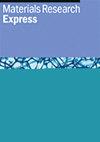釉面空心微珠保温砂浆的性能和机理研究
IF 2.2
4区 材料科学
Q3 MATERIALS SCIENCE, MULTIDISCIPLINARY
引用次数: 0
摘要
随着人们对节能和环保的关注与日俱增,对釉面空心微珠保温砂浆的研究显得至关重要。这种砂浆具有优异的隔热性能,可降低能耗和排放,符合当前绿色建筑的发展趋势。本文旨在通过正交实验研究不同组分比例对保温砂浆参数的影响,实验包含四个因素和三个层次:釉面空心微珠、海泡石、引气剂和纤维素醚。此外,还进行了单因素实验,分析水固比和这四个因素的影响程度。然后通过扫描电子显微镜(SEM)观察验证了实验结果。研究结果表明,釉面空心微珠对导热系数和抗压强度的影响最大,而引气剂对抗弯强度的影响最大。具体来说,当釉面空心微珠含量为 2%、海泡石含量为 1%、引气剂含量为 0.6%、纤维素醚含量为 0.6%时,导热系数最低可达 0.0533W/(m-K)。另一方面,当釉面空心微珠含量为 1%、海泡石含量为 2%、引气剂含量为 0.4%、纤维素醚含量为 0.6%时,抗压强度最高可达 2.4 兆帕。这些研究结果为进一步探索提高保温砂浆的性能奠定了坚实的基础。本文章由计算机程序翻译,如有差异,请以英文原文为准。
Study on the properties and mechanisms of the glazed hollow bead thermal insulation mortar
With increasing concerns for energy conservation and environmental protection, research on glazed hollow bead thermal insulation mortar is of utmost importance. This type of mortar offers superior thermal insulation, leading to reduced energy consumption and emissions, in line with the current green building trends. This article aims to investigate the impact of varying component proportions on the parameters of thermal insulation mortar through an orthogonal experiment with four factors and three levels: glazed hollow bead, sepiolite, air-entraining agent, and cellulose ether. Additionally, a single-factor experiment is conducted to analyze the influence degree of water-solid ratio and these four factors. The experimental results are then verified through SEM (Scanning Electron Microscope) observation. The research findings indicate that glazed hollow beads have the most significant impact on thermal conductivity and compressive strength, while the air-entraining agent exerts the greatest influence on flexural strength. Specifically, when the content of glazed hollow bead is 2%, sepiolite 1%, air-entraining agent 0.6%, and cellulose ether 0.6%, the thermal conductivity can reach a minimum value of 0.0533W/(m·K). On the other hand, when the content of glazed hollow bead is 1%, sepiolite 2%, air-entraining agent 0.4%, and cellulose ether 0.6%, the compressive strength can achieve a maximum value of 2.4 MPa. These findings provide a solid foundation for further exploration into improving the performance of thermal insulation mortar.
求助全文
通过发布文献求助,成功后即可免费获取论文全文。
去求助
来源期刊

Materials Research Express
MATERIALS SCIENCE, MULTIDISCIPLINARY-
CiteScore
4.50
自引率
4.30%
发文量
640
审稿时长
12 weeks
期刊介绍:
A broad, rapid peer-review journal publishing new experimental and theoretical research on the design, fabrication, properties and applications of all classes of materials.
 求助内容:
求助内容: 应助结果提醒方式:
应助结果提醒方式:


